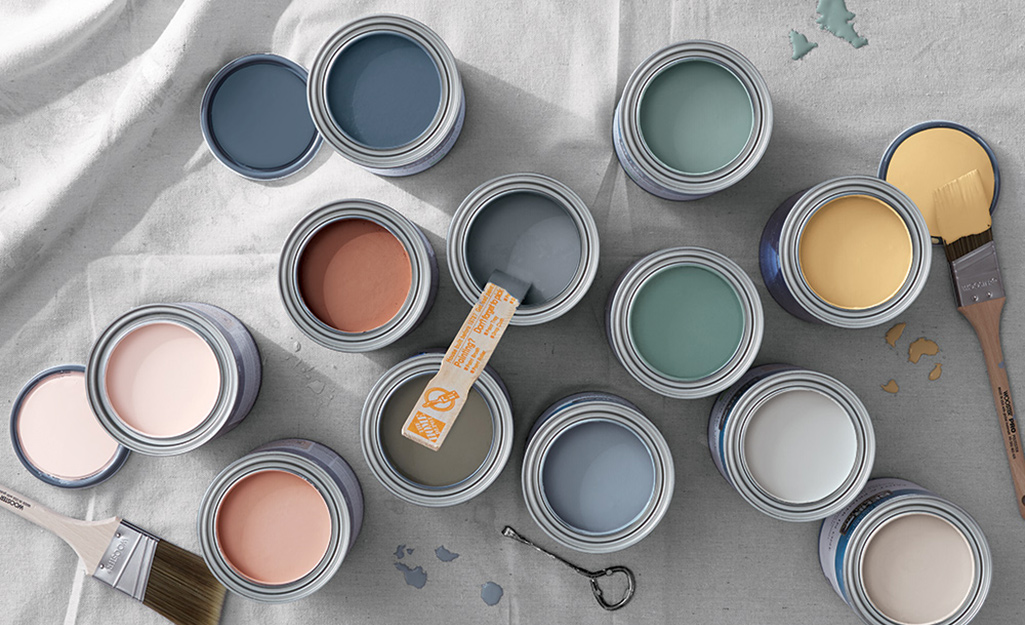Ceiling paint is not like regular wall paint. It has unique properties. These make it perfect for ceilings. Let’s explore what makes ceiling paint special.

Credit: www.homedepot.com
Unique Features of Ceiling Paint
Ceiling paint has several special features. These include:
- High Viscosity
- Matte Finish
- Low Spatter
- Excellent Coverage
High Viscosity
Ceiling paint is thicker than wall paint. This high viscosity helps it stay on the ceiling. It does not drip easily. This makes painting ceilings easier and less messy.
Matte Finish
Ceiling paint usually has a matte finish. This finish hides imperfections well. Ceilings often have small cracks or bumps. Matte paint covers these up, making the ceiling look smooth.
Low Spatter
When you paint a ceiling, you are working above your head. Paint splatters can be a problem. Ceiling paint is designed to spatter less. This keeps your floor and furniture cleaner.
Excellent Coverage
Ceiling paint covers well in one coat. This is important. Painting a ceiling is hard work. You do not want to do it twice. Good coverage saves time and effort.
Ceiling Paint vs. Wall Paint
Ceiling paint and wall paint are different. Here is a table comparing the two:
| Feature | Ceiling Paint | Wall Paint |
|---|---|---|
| Viscosity | High | Medium |
| Finish | Matte | Various (Glossy, Matte, Satin) |
| Spatter | Low | Medium to High |
| Coverage | Excellent | Good |
Benefits of Using Ceiling Paint
Using ceiling paint has many benefits. These include:
- Easy Application
- Better Aesthetic
- Time-Saving
- Cost-Effective
Easy Application
Ceiling paint is easy to apply. Its thickness and low spatter make the job simpler. You do not need to worry about drips and splatters.
Better Aesthetic
A matte finish looks great on ceilings. It hides flaws and provides a smooth look. Your room looks more polished and complete.
Time-saving
Ceiling paint covers in one coat. This saves time. You can finish the job quickly. No need for multiple coats.
Cost-effective
One coat coverage also saves paint. You use less paint for the job. This makes it more cost-effective.
How to Choose the Right Ceiling Paint
Choosing the right ceiling paint is important. Here are some tips:
- Check the Viscosity
- Look for Matte Finish
- Consider Low Spatter
- Read Reviews
Check The Viscosity
Make sure the paint is thick enough. High viscosity is key for ceiling paint.
Look For Matte Finish
Matte finish hides imperfections. It is ideal for ceilings.
Consider Low Spatter
Low spatter means less mess. This is important for ceiling painting.
Read Reviews
Look at reviews from other users. See what they say about the paint. This can help you make a good choice.

Credit: www.mastertouchpainting.com
Steps to Paint a Ceiling
Painting a ceiling is a step-by-step process. Here are the steps:
- Prepare the Room
- Clean the Ceiling
- Apply Primer
- Paint the Ceiling
Prepare The Room
Move furniture out of the room. Cover the floor with a drop cloth. Tape around the edges of the ceiling.
Clean The Ceiling
Dust and clean the ceiling. Use a damp cloth to remove dirt.
Apply Primer
Apply a primer coat. This helps the paint stick better.
Paint The Ceiling
Use a roller to apply the paint. Start in one corner and work your way across. Make sure to use even strokes.
Common Mistakes to Avoid
There are some common mistakes when painting a ceiling. Avoid these to get the best results:
- Not Using Primer
- Using the Wrong Paint
- Skipping the Edges
- Applying Too Much Paint
Not Using Primer
Primer helps paint adhere better. Do not skip this step.
Using The Wrong Paint
Use paint designed for ceilings. Wall paint will not work as well.
Skipping The Edges
Paint the edges first. This ensures a clean, even finish.
Applying Too Much Paint
Apply paint in thin, even layers. Too much paint can drip and create a mess.
Frequently Asked Questions
What Is Ceiling Paint Used For?
Ceiling paint is specially formulated for overhead surfaces, providing a uniform finish and hiding imperfections.
How Is Ceiling Paint Different?
Ceiling paint has a thicker consistency, reducing drips and splatters, and often features a matte finish.
Can I Use Wall Paint On Ceilings?
Wall paint can be used, but ceiling paint offers better coverage and fewer drips for overhead applications.
Does Ceiling Paint Need A Primer?
Using a primer is recommended for better adhesion and coverage, especially on new or repaired ceilings.
Conclusion
Ceiling paint is special because of its unique features. High viscosity, matte finish, low spatter, and excellent coverage make it ideal for ceilings. Using ceiling paint provides many benefits. It is easy to apply, looks great, saves time, and is cost-effective. Follow the steps and tips to get the best results. Happy painting!